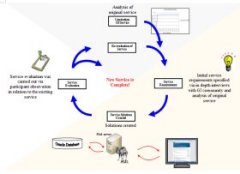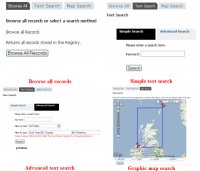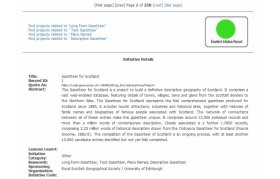Background:
In 2006, a partnership between The University of Edinburgh, The Scottish Government and The Association of Geographic Information in Scotland
lead to the production of an online service designed to encourage diffusion of knowledge across the Scottish GI community and beyond.
The project, part of the One Scotland - One Geography initiative, aimed to create a service whereby metadata about projects
could be shared in order to create synergies and reduce repetition across the GI community. The purpose of this project was to review and
enhance a prototype Geographical Information Projects Registry (GIPR) to create a self-sustaining user-driven service. The resource exists as
a database driven website which is accessed via the World Wide Web (WWW). The service can be found at
www.gisprojects.net. The project aimed to provide a more intelligent, user-driven website which
requires little or no administration. The project aims to achieve this through highlighting synergies, using new methods to keep
the database current and by providing alternative techniques of keeping users informed of new information obtained by the registry.
Methodology:
|
The project methodology was modelled on ISO 13407, Human Centred Design Processes for Interactive Systems.
- To understand and identify the context of use
- To identify service requirements for the user
- To produce service solutions
- To evaluate the service solutions created
|

|
|
The first phase of the methodology consisted of an evaluation of the original GIPR to identify the context of use;
from this service requirements were formulated to overcome the limitations experienced.
These service requirements were validated through in-depth interviews with informed members of the GI community.
From these service requirements, a series of service solutions were developed to form a prototype GIPR.
In the final stage of the process, the service solutions were evaluated by a small user group via participant observation.
|
Service Requirements:
|
The service requirements formulated in steps 1 and 2 are shown in the table below.
|
|
Proposed service requirement for new GIPR
|
Expected benefits
|
|
Improve search facilities
|
- Simpler search facility will be more appealing to users
- New methods of searching such as graphically through maps will help more users to find synergies
|
|
Improve facilities for synergy discovery
|
- Improvements in the discovery of synergies through string manipulation
- Increased value as business tool
|
|
Utilise additional functions for encouraging update of service and rewarding good practice
|
- Fewer out of date projects
- Fewer incomplete project records
- Users more likely to retain interest in GIPR
|
Service Solutions:
|
The service requirements were used to construct a system which meets the needs of the user.
The system consists of three main divisions; the database and middleware on the server side and the viewing software (web browser)
on the client side.
|

|
Searching:
|
The search page was simplified to provide a more intuitive search facility with a single text box.
It was also decided that additional search facilities should be retained.
These facilities were organised with a tab system so as to be less imposing users.
|

|
- Browse all - This allows users with no specific search goals to browse the registry.
- Advanced search - Allows more complex 'time-based' queries and also allows users to query a single field. The features can be used cumulatively to build compound queries.
- Graphical map search - This method of searching allows users to search on a geographical area.
|
Synergy Pointing:
|
The service is designed to help users find and pinpoint synergies between projects;
however no facilities existed in the original GIPR to achieve this.
A system of automatically generating hyperlinks pointing to potentially related projects was therefore developed.
|

|
Maintaining critical mass and quality of project records was identified as a key area in which the GIPR required improvement.
Email System:
To address this, an intelligent email system was developed.
The automated system reminds users to update their records and also suggests areas in which the record could be expanded.
|

|
Project Rating:
|

|
A rating system utilising the 'Designed Incentives' approach was proposed (Harper, 2007).
Three prototypes were built; a star rating system, a comments system and a traffic lights rating system.
The designed incentives philosophy states that a rating system should reward users for good practice whilst encouraging those
utilising poor practice. The traffic lights system was found to be the system which best met these goals;
therefore it was included in the final release.
|
RSS:
Finally, RSS feeds were developed to allow the users to keep up to date with new developments in the GIPR and new projects
in their area of interest.
|
Assessment of User Needs:
|
User surveys were conducted to ascertain areas in which the user experience could be improved and also areas where the site did
not meet the service requirements. As a result of the surveys, several changes were implemented.
The respondents were asked to re-evaluate the system after the changes had been made.
The feedback suggested that the changes were successful.
|
Conclusions:
This project set out to build a registry of Geographical Information projects which would help to create synergies within
the Scottish GI community. The project methodology which was followed ensured that the service met the requirements set forth;
however, longer term study is required to fully measure the effects this might have.
The GIPR was built within the framework of Scottish Government strategy and to conform to EU policy.
It utilises current and developing technologies to harness a community from which knowledge can be extracted and shared.
Through engendering a community with technology, it is hoped the objectives of the GIPR can be achieved.
References:
- Bruce, D. 2008, "A development of the Geographical Information Projects Registry in line with the Scottish Geographic Information Strategy; 'One Scotland - One Geography.'", Unpublished Master Thesis, The University of Edinburgh, Scotland.
- Harper, M. 2007, "Encouraging Contributions to Online Communities with Personalization and Incentives", User Modelling, p.460-464
- Lee, Z., Im, I. and Lee, S. 2000, "The Effect of Negative Buyer Feedback on Prices in Internet Auction Markets", Proceedings of the Twenty-first International Conference on Information, pp. 286-287.
- McLaren, R. 2008. [Personal communication]. 09 June
- Traynor, M. and Keegan , C. 2008. [Personal communication]. 27 May









